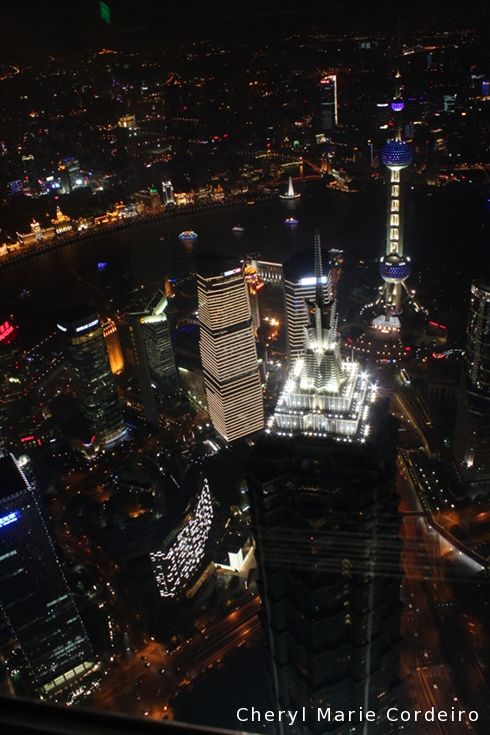
Like many other cities in the world, Gothenburg, Sweden, has a ”friendship city” (youhao chengshì) agreement, with the city of Shanghai.
Text and Photo © JE Nilsson, CM Cordeiro 2013
The ideas in this post covers at best, an intuitive and metaphorical exploratory mapping of some aspects of quantum physics theory, to phenomenon that can be observed in the material world so governed by the laws of nature. Perhaps a tall argument to make, but I’ll try here to figuratively map the concept of quantum entanglement onto the observation of its potential manifestation in international business, taking the the example of Twin Cities, defined as two cities in different regions that have made an agreement on for example cultural exchange and economic cooperation.
It is here not to apply the theories of quantum physics to the material world, because that cannot always be, due to that the quantum world has different laws than that of the physical world. But just to sketch an idea that what is now being observed and measured to accuracy in the quantum realm with its attached values, named phenomenon A’ {-V(N) to +V(N)} is perhaps manifested in the material world of classical physics as phenomenon A {-V(N) to +V(N)}, if one were to view it from a systems level perspective, here defined as the manner of progression of development.
Artist and movie maker David Lynch
I was mid-teens the 1990s when the David Lynch’s tv-series Twin Peaks in the genre of psychological-thriller was aired. The series was created by David Lynch and Mark Frost with the characterizing theme, nothing was what it looked like.
In Twin Peaks David Lynch played with quantum physics theories as applied to our ”classical” world. By juxtaposing space-time and letting characters appear at two different places at the same time, he for one thing showed how objective reality could be much less certain than we would like to believe, calling to mind some great philosophical debates from the time of Socrates and Plato on what is ’reality’?
A self-reflexive perspective of a hyper-reality occurring in non-linearity
The instrumental introduction, Falling, by Angelo Badalamenti, worded and later sung by Julee Cruise in 1990 had me listening to both versions on repeat for months during the 1990s. As much as it had related to my life’s events of the time, of the process of growing up, it was simply also a haunting melody that struck a certain melancholic cord within.
In similar manner, the unreleased soundtrack by Lynch and Badalamenti, And Still for Lost Highway (1997), sung by Jocelyn West is equally haunting. The discourse of Lost Highway offered a self-reflexive perspective of a hyper-reality occurring in non-linearity. The presentation, interpretation and subsequent deconstruction of which left audiences worldwide in a range of reactions from awe to confusion, applaud to controversy.
In the past decades, though Lynch’s ideas combined with Badalamenti’s music have captured audiences and critics worldwide, not much was discussed about the processes of the making of Lynch’s work. But while many today continue to relegate these works to the realm of mysticism and spiritualism, a new perspective is opening on Lynch’s works much due to the advancing science of quantum physics, as distinguished from classical physics.
Classical physics tend to document and explain everything that is materially observable, whilst quantum physics seeks to know what is not directly observable. In line with Professor Robert Dijkgraaf and in half jest, quantum physics is the study of ”nothingness”, a space where most people would overlook, but where everything interesting happens.
The End of Space and Time? – Professor Robert Dijkgraaf from Gresham College on Vimeo.
While knowledge in quantum physics and biology are in themselves progressing at exponential speed, their research findings and applicability outside of their own fields of expertise is hardly tapped upon by other academic fields. This is as much due to that there is simply too much information to manage, as it is due in tradition that academic disciplines do not generally cooperate in a cross-border fashion.
The works of David Lynch has been put in an explanatory light much due to Martha Nochimson’s research on Lynch’s production, where she argues that three main theories in quantum physics are the inspirational forces behind much of Lynch’s work.
The first is quantum entanglement – a theory which describes how paired particles can affect each other at great distances, and even behave as if they were a complementary single unit. Entanglement research began in 1935 by Einstein, Podolsky and Rosen, initially as a critique on quantum mechanics, but is today recognized as a valid, fundamental feature of quantum mechanics. It is utilized as a resource for communication and computation.
The second is Hugh Everett’s multi-worlds interpretation, the fundamental idea going back to Everett 1957 is that there are myriads of worlds in the Universe in addition to the world we are aware of.
The third is the fundamental principle of quantum superposition, which holds that a physical system exists partly in all its theoretically possible states simultaneously, but when measured or observed, it gives a result corresponding to only one of the possible configurations.
Quantum physics figurative mapping onto International Business
The mapping of ideas from quantum physics onto international business, complexity management and organizational structures is for me, as how the quantum entanglement of paired particles is manifest in the deliberate economic twinning of two distinct cities across regions in classical physics. The connecting perspective, would be one of a Systems Level Theory.
Working with the assumption that organizational growth and development proceed in the manner of an ordered sequence rather than in an hierarchical structure, then the manner in which to actualize congruent management or policy making is to build an organizational infrastructure that can cope with a systems level approach to organizational problems or challenges, with the aim of coming to a targeted level solution.
This would in turn suggest an organic shift towards heterarchous groups, working in loose networks towards a common goal, much like the workings of the building of Wikipedia or the Linux OS.
This is not to say that in an organizational form like this there would be no administration to the organization or that there would be no need for a central decision-making point, but rather, to say that the suprastructure would be one that both creates and is created by these heterarchous groups. That the voices in the decision-making process like this would be many, but would work in a singular direction.
A Systems Level approach to congruent management strategies would be one where a variety of management styles are leveraged within the same organization, applied to different groups of employees depending on their level of need, context of situation and projected career path within and beyond the organization.
Bridging Art and Science
Quantum calculations and technicalities aside, the study and review of film and art and in this case, that of Lynch’s work acts in my view as an inspiration towards a bridging between disciplines.
To that end, Swedish director, writer and producer for film, stage and television, Ingmar Bergman once lyrically captured the essence of the study of quantum physics:
”Film has dream, film has music. No form of art goes beyond ordinary consciousness as film does, straight to our emotions, deep into the twilight room of the soul. A little twitch in our optic nerve, a shock effect: twenty-four illuminated frames in a second, darkness in between, the optic nerve incapable of registering darkness. At the editing table, when I run the trip of film through, frame by frame, I still feel that dizzy sense of magic of my childhood: in the darkness of the wardrobe, I slowly wind one frame after another, see almost imperceptible changes, wind faster — a movement.
~ in Laterna Magica (1987); The Magic Lantern : An Autobiography as translated by Joan Tate (1988)
Integrating perspectives from various fields
In the China we are now looking at with awe, how they build and develop their society with breakneck speed, education is equaled with not only pure science but knowledge of the classics in literature, the ability to read, understand, appreciate and even write poetry. A deep understanding of history, philosophy and religion is taken for granted among the top leaders of the society.
In my view, coordinated efforts of interaction between various disciplines with the aim of integrating perspectives from various fields of knowledge is always a good thing. There is a truth in, that the higher you climb, the more you see, and what you have once seen, you can never unsee.
This, for example, isn’t this a nice model on how an idea is spread?

Heisenbergs uncertainty principle.
The evolution of an initially very localized gaussian wave function of a free particle in two-dimensional space, with colour and intensity indicating phase and amplitude. The spreading of the wave function in all directions shows that the initial momentum has a spread of values, unmodified in time; while the spread in position increases in time: as a result, the uncertainty Δx Δp increases in time.
References
- Angelo Badalamenti explains how he created the music for Twin Peaks. Vimeo.
- Cuise, Julee. Falling. 1990.
- Dries, M. 1999. David Lynch’s Lost Highway: Perpetual Mystery or Visual Philosophy.
- Ker Than, 2013. National Geographic News, March 2013. Physicists Increasingly Confident They’ve Found the Higgs Boson.
- Overbye, D. 2006. New tests of Einstein’s ’spooky’ reality. The New York Times, Healthscience. Published: Tuesday, January 10, 2006
- Pretty as a Picture: the Art of David Lynch. 1997.
- Tate, J. 1988. The Magic Lantern, Ingmar Bergman. Translated by Joan Tate New York, Viking Press.
- Sjögren, J. 2012. Mystik och fysik nycklarna till Lynchs filmer. SvD Kultur. 22 March 2013.
- Stanford Encyclopedia of Philosophy. Many Worlds Interpretation.